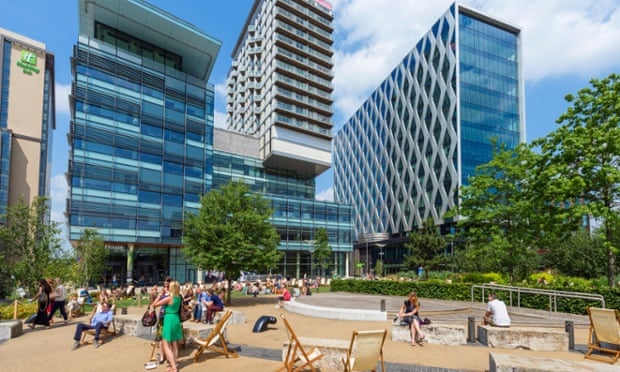Five cities where planning went right
Britain’s planning departments have lost nearly half of their budgets over the past four years, and more spending cuts are expected. Ahead of a report on Monday calling for more power to be devolved to cities, the Royal Town Planning Institute’s Richard Blyth picks examples – from Gateshead to the Olympic Park – where good planning made the difference. Do you agree?

The Royal Town Planning Institute, which represents 23,000 planners in the public, private, charitable and education sectors, is 100 years old this year. On Monday we launch a major new report, celebrating planning innovation, calling for more powers to be devolved to cities, and warning that further cuts could jeopardise growth. The report, Success and Innovation in Planning, backs the government coalition’s localism agenda but says it’s being held back by a lack of resources, and that local authorities need more power if they are to help regenerate Britain’s towns and cities.
Britain still has one of the most centralised planning systems in the world, and strategic planning capacity is increasingly being removed from regional control. Yet an overwhelming majority of people (79%) want a bigger say over the development of their communities, and the benefits of successful localism would be huge: the planning process could be used to tackle wider societal challenges such as ageing, economic growth and environmental degradation, as well as engage communities about the issues that really matter to them. However, planning departments have lost 46% percent of their budget over the last four years. With more spending reductions due, we fear it could make Britain’s housing crisis worse and limit innovative thinking.
Here are five developments where we think good urban planning made the difference.
Lea Valley, London: Olympic redevelopment

The redevelopment of Lea Valley for the London Olympic and Paralympic Games put equal focus on its long-term legacy and on the Games themselves. The Olympic Park itself was assembled using a range of planning tools: primarily the use of compulsory purchase orders to assemble a single large tract of land. While nothing new, this is increasingly rare in UK planning. The design of the Park is also noteworthy. Many buildings were built to only be temporary or have aspects that could later be changed; the athletes’ village was designed to be easily converted into homes.
The plan was a model of coordination, with the report singling out the Olympic Delivery Authority and London Legacy Development Corporation for their efforts. This kind of multi-agency approach is now the model for other regeneration projects, such as Old Oak Common/Park Royal in London. The focus on legacy was able to draw on two decades of planning work in the Lea Valley and the wider Thames Gateway to develop a long-term vision for a new city district. In doing so, the statutory planning system was used, rather than bypassed (as had been the case in other similar projects). Lea Valley shows what can be done with the system, given the political will.
Bristol: Neighbourhood Planning Network
Bristol city council’s localism agenda delivered a radical approach, allowing planning to be influenced from the bottom up via its Neighbourhood Planning Network (NPN), thus drawing on the city’s distinctive and vibrant civic culture.
The council has a long history of engaging with communities on how to make better places, most of which pre-dates the current government’s own localism agenda. The best example of Bristol’s localism policy is the NPN, which is a network of around 45 neighbourhood groups. It was set up in 2006 and acts as a coordinating body for community involvement in planning issues.
Manchester and Salford: cultural regeneration
In Salford Quays, new homes for the Lowry collection and the Imperial War Museum North served as “cultural anchors” for the area’s turnaround, while a new lifting footbridge improved connectivity. The relocation of parts of the BBC to the new Media City Salford development cemented the Quay’s new position as a cultural hub. The planning built on the strengths of the area, including the presence of a waterfront, a tram and existing media industries, and benefited from public investment in cultural assets. One element that perhaps distinguishes the Salford Quays from other waterfront regeneration projects was the ownership of the land. Once the docks closed in 1982, Salford council purchased the whole site from the Manchester Ship Canal Company. This gave the council more control over the master-planning of the area.
In Manchester city centre, meanwhile, the cultural regeneration focused on popular music attracting students and purpose-built accommodation, together with the remodeling of the Corn Exchange. The success stemmed from the planning and design. Architecturally, the plans replaced the 1960s Arndale Centre with buildings of better quality, more natural light and greater attention to external spaces. Part of this process created buildings and spaces for civic use, for example Piccadilly Gardens and the newly remodelled Corn Exchange, which was reimagined as an upmarket destination.
Newcastle and Gateshead Quays: conservation

The Grainger Town Partnership regenerated Newcastle city centre, by conserving local architecture in a way that could drive the local economy. A special collaboration (it was a company limited by guarantee, with a partnership board of 20 members including representatives from the council, key public agencies, the private sector and residents), the Partnership turned around a declining part ofNewcastle, using – as in the Manchester case – the beauty inherent in the architecture for economic gain as well as conservation. Local engagement was critical. Engaging a wide range of stakeholders to develop informal plans for the area helped inspire confidence across the community, as did the use of high-quality design to drive up standards for private investment.
The regeneration of Gateshead Quays highlights the importance of a long-term, flexible yet inspiring vision. The Quays have a history of investment in arts and culture, and there was a high degree of flexibility throughout. Indeed, the council was rather reserved early on about the potential scale of its ambitions, hoping to keep land values low. One early change in the plan was to separate the two anchor attractions, the Baltic and Sage Gateshead, creating a space between the two buildings for events and other development projects.

Newhall, Essex: a new garden city
A new garden city development on the edge of Harlow, Newhall offers useful lessons in planning to ensure diverse and liveable spaces. The first is having a strong, coherent design ethos – this was embodied in the “Book of Newhall”, which acted as a design guide and manifesto, setting the tone for the development and requiring developers to move beyond their standard house-types. Second is the use of different developers and architects, with the development divided into plots and put out to tender. This is an approach that has been used to great effect in many northern European countries, which often encourage individual differentiation in design. The result was a series of strong, distinctive architectural types.
Third was the creation of a mix of live/work units and commercial spaces on the ground floor of residential buildings along the main road. Lastly, the development benefited from landowners who took an active interest in planning and development: the Moen family, who owned the site, took the long-term view and sought to increase the site’s overall value.
Richard Blyth is head of policy at the Royal Town Planning Institute
Paris Wants to Keep Central Neighborhoods From Becoming 'Ghettos for the Rich'
The French capital has announced a plan to stop housing displacement in gentrifying neighborhoods. It might be the most radical proposal Europe has seen.

What can you do when a once socially mixed neighborhood starts turning into a “ghetto for the rich”? Quite a lot, according to the city of Paris. As part of a massive home-building drive, the government of France’s capital has just announced a plan to stop housing displacement in central neighborhoods. It might just be the most radical Europe has yet seen. Earlier this week, the Conseil de Paris published a list of 257 addresses (containing over 8,000 apartments) that the city would have a "right of first-refusal" to buy, in order to convert to subsidized housing. Located in areas that are being gentrified, the city’s plans would both increase subsidized rental options and ensure that at least some housing in these areas remains affordable to lower- and middle-income residents. The plans operate within existing laws rather than creating new ones—but as you can imagine, real-estate professionals aren’t exactly delighted with the proposals.
The nuts and bolts of the plan are as follows. When apartments at any of the 257 addresses come up for sale, they must by law be offered first to the city. The apartment should still be sold at the market price —but the price offered would nonetheless be decided by the city, not the seller. If the landlord doesn’t like what’s offered, he or she can appeal to an independent judge to have it re-priced, or can withdraw the property from the market. What the landlord can’t do, however, is sell the apartment on to someone else without the city having bowed out first.
The broader social-engineering goals here are clear to anyone familiar with Paris when you look at where the addresses are distributed on the map. Typically they are in formerly working-class neighborhoods in northern and eastern Paris—Ménilmontant, the slopes north of Montmartre, the eastern end of the Bastille—where lower-income residents are being displaced. In places, the list even reads a bit like a gentrifiers’ streetfinder, with addresses on busy, broadly hip café and restaurant strips Rue Oberkampf, Rue Jean Pierre Timbaud, and Rue de Charonne. According to mayor’s aide Ian Brossat, the move is about:
Whether it actually works remains to be seen. Parisians voted in the current mayor with a healthy majority knowing such moves could be in the cards, but Paris’ real estate industry is aghast. They fear that the measures could discourage buying and selling in an already sluggish market. It’s true that the measures come at a time when Paris rents are actually going down: After years of steady rises, Paris prices actually fell by 2.8 percent in 2014’s first quarter. Real-estate brokers also claim that that prices set by the city may still oblige owners to sell at sub-market prices. The mayor of Paris’ 18th arrondissement, which hosts the largest number of addresses on the list, has also made a plea for the city to focus on middle-income Parisians, who he alleges are the “great forgotten ones." The city’s self-expressed intention, however, is not to displace existing residents from these addresses, but to ensure that they remain safe from landlords bent on evicting them and redeveloping their buildings.
Even for those who are broadly supportive of the plan, there’s still a big question: Is setting aside such a large sum to buy potentially expensive property really the best use of public funds? Couldn’t the money could be used to actually build more apartments elsewhere?
For this one at least, the city has an answer ready. The right of refusal plan is just one part of a massive housing push planned for the next six years, one which will see 10,000 new apartments built every year, with 70 percent of this total made up of subsidized housing. The overall budget is €10 billion ($12.3 billion U.S.), and comes alongside plans to convert office space into housing and relax some height limits for public buildings. The high targets are possible partly because the city is working with the Paris transit authority RATP to free up development land. Using a potential maximum 9 percent of this budget for right of refusal plans doesn’t seem excessive.
We’ll have to wait a decade or so to see if Paris’ new plans genuinely succeed in making it a more liveable, diverse city. But in a world where city after city is throwing up their hands and doing almost nothing to combat displacement, exorbitant housing costs, and their negative effects, it deserves credit for really trying.
The nuts and bolts of the plan are as follows. When apartments at any of the 257 addresses come up for sale, they must by law be offered first to the city. The apartment should still be sold at the market price —but the price offered would nonetheless be decided by the city, not the seller. If the landlord doesn’t like what’s offered, he or she can appeal to an independent judge to have it re-priced, or can withdraw the property from the market. What the landlord can’t do, however, is sell the apartment on to someone else without the city having bowed out first.
The broader social-engineering goals here are clear to anyone familiar with Paris when you look at where the addresses are distributed on the map. Typically they are in formerly working-class neighborhoods in northern and eastern Paris—Ménilmontant, the slopes north of Montmartre, the eastern end of the Bastille—where lower-income residents are being displaced. In places, the list even reads a bit like a gentrifiers’ streetfinder, with addresses on busy, broadly hip café and restaurant strips Rue Oberkampf, Rue Jean Pierre Timbaud, and Rue de Charonne. According to mayor’s aide Ian Brossat, the move is about:
Choosing diversity and solidarity, against exclusion, social determinism and the centrifugal logic of the market. It also aims to reduce inequalities between the east and the west of Paris in particular, developing social supply where it is insufficient.The plan’s ambition will come at a cost—literally. If the city is genuinely going to pay market prices, the plan could be expensive, which is why it has set aside €850 million ($1.05 billion U.S.) for purchases. In reality, as this is a right of first-refusal rather than an outright purchase plan, only 100 or so apartments may be bought up during current mayor Anne Hidalgo’s tenure. The idea is essentially to give Paris the ability to act as a social-mix monitor, steeping in to prevent social segregation in the public interest if they feel it is under threat.
Whether it actually works remains to be seen. Parisians voted in the current mayor with a healthy majority knowing such moves could be in the cards, but Paris’ real estate industry is aghast. They fear that the measures could discourage buying and selling in an already sluggish market. It’s true that the measures come at a time when Paris rents are actually going down: After years of steady rises, Paris prices actually fell by 2.8 percent in 2014’s first quarter. Real-estate brokers also claim that that prices set by the city may still oblige owners to sell at sub-market prices. The mayor of Paris’ 18th arrondissement, which hosts the largest number of addresses on the list, has also made a plea for the city to focus on middle-income Parisians, who he alleges are the “great forgotten ones." The city’s self-expressed intention, however, is not to displace existing residents from these addresses, but to ensure that they remain safe from landlords bent on evicting them and redeveloping their buildings.
Even for those who are broadly supportive of the plan, there’s still a big question: Is setting aside such a large sum to buy potentially expensive property really the best use of public funds? Couldn’t the money could be used to actually build more apartments elsewhere?
For this one at least, the city has an answer ready. The right of refusal plan is just one part of a massive housing push planned for the next six years, one which will see 10,000 new apartments built every year, with 70 percent of this total made up of subsidized housing. The overall budget is €10 billion ($12.3 billion U.S.), and comes alongside plans to convert office space into housing and relax some height limits for public buildings. The high targets are possible partly because the city is working with the Paris transit authority RATP to free up development land. Using a potential maximum 9 percent of this budget for right of refusal plans doesn’t seem excessive.
We’ll have to wait a decade or so to see if Paris’ new plans genuinely succeed in making it a more liveable, diverse city. But in a world where city after city is throwing up their hands and doing almost nothing to combat displacement, exorbitant housing costs, and their negative effects, it deserves credit for really trying.
沒有留言:
張貼留言